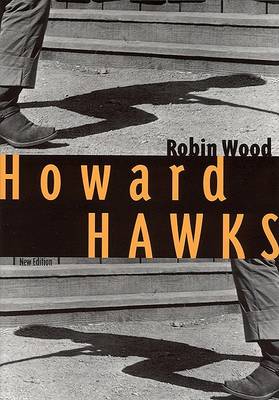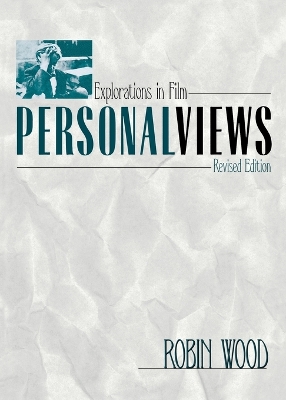Contemporary Approaches to Film and Media
3 total works
Prolific director Howard Hawks made films in nearly every genre, from gangster movies like ""Scarface"" to comedies like ""Bringing Up Baby"" and ""Monkey Business"" and westerns like ""Rio Bravo."" In this new edition of a classic text, author Robin Wood explores the ways in which Hawks pushed the boundaries of each genre and transformed the traditional forms in new, interesting, and creative ways. This reprint also contains an exciting new introduction by Wood, which shows how his thinking about Hawks has deepened over time without fundamentally changing. Since its original publication in 1972, Wood's ""Howard Hawks"" has set the terms for virtually all subsequent discussions of the director. The provocative chapters demonstrate the ways in which Hawks's films were affected by the director's personality and way of looking at and feeling things, and by his celebration of instinct, selfrespect, group responsibility, and male camaraderie. Wood's connections between the professionalism of Hawks's action films and comedies, with their ""lure of irresponsibility,"" has become a standard way of conceptualizing Hawks's films and the model to which all later critical work has had to respond. This book remains as contemporary as when it was first released, although it is grounded in the auteur period of its publication.
Robin Wood, the renowned scholarly critic and writer on film, has prepared a new introduction and added three essays to his classic text ""Personal Views."" This important book contains essays on a wide range of films and filmmakers and considers questions of the nature of film criticism and the critic. Wood, the proud ""unreconstructed humanist,"" offers in this collection persuasive arguments for the importance of art, creativity, and personal response and also demonstrates these values in his analyses. ""Personal Views"" is the only book on cinema by Wood never to have been published in the United States. It contains essays on popular Hollywood directors such as Howard Hawks, Vincente Minnelli, and Leo McCarey; as well as pieces on recognized auteurs like Max Ophuls, Orson Welles, Fritz Lang, and Josef von Sternberg; and essays on art-film icons Jean-Luc Godard, Michelangelo Antonioni, and Kenji Mizoguchi. The writings that make up ""Personal Views"" appeared during a pivotal time in both film studies - during its academic institutionalization - and in the author's life. Throughout this period of change, Wood remained a stalwart anchor of the critical discipline, using theory without being used by it and always staying attentive to textual detail. Wood's overall critical project is to combine aesthetics and ideology in understanding films for the ultimate goal of enriching our lives individually and together. This is a major work to be read and reread not just by film scholars and students of film but by anyone with an interest in twentieth-century culture.
The Apu Trilogy is the fourth directorial monograph written by influential film critic Robin Wood and republished for a contemporary audience. Focusing on the famed trilogy from Indian director Satyajit Ray, Wood persuasively demonstrates his ability at detailed textual analysis, providing an impressively sustained reading that elucidates the complex view of life in the trilogy. Wood was one of our most insightful and committed film critics, championing films that explore the human condition. His analysis of The Apu Trilogy reveals and illuminates the films' profoundly humanistic qualities with clarity and rigor, plumbing the psychological and emotional resonances that arise from Ray's delicate balance of performance, camerawork, and visual design. Wood was the first English language critic to write substantively about Ray's films, which made the original publication of his monograph on The Apu Trilogy unprecedented as well as impressive. Of late there has been a renewed interest in North America in the work of Satyajit Ray, yet no other critic has come close to equaling the scope and depth of Wood's analysis.
In his introduction, originally published in 1971, Wood says Ray's work was met with indifference. In response, he offers possible reasons why this occurred, including social and cultural differences and the films' slow pacing, which contemporary critics tended to associate with classical cinema. Wood notes Ray's admiration for Western film culture, including the Hollywood cinema and European directors, particularly Jean Renoir and his realist films. Assigning a chapter to each Pather Panchali (1955), Aparajito (1957) and The World of Apu (1959), Wood goes on to explore each film more thoroughly. One of the aspects of this book that is particularly rewarding is Wood's analytical approach to the trilogy as a whole, as well as detailed attention given to each of the three films. The book, with a new preface by Richard Lippe and foreword by Barry Keith Grant, functions as a masterclass on what constitutes an in-depth reading of a work and the use of critical tools that are relevant to such a task.
Robin Wood's The Apu Trilogy offers an excellent account of evaluative criticism that will appeal to film scholars and students alike.
In his introduction, originally published in 1971, Wood says Ray's work was met with indifference. In response, he offers possible reasons why this occurred, including social and cultural differences and the films' slow pacing, which contemporary critics tended to associate with classical cinema. Wood notes Ray's admiration for Western film culture, including the Hollywood cinema and European directors, particularly Jean Renoir and his realist films. Assigning a chapter to each Pather Panchali (1955), Aparajito (1957) and The World of Apu (1959), Wood goes on to explore each film more thoroughly. One of the aspects of this book that is particularly rewarding is Wood's analytical approach to the trilogy as a whole, as well as detailed attention given to each of the three films. The book, with a new preface by Richard Lippe and foreword by Barry Keith Grant, functions as a masterclass on what constitutes an in-depth reading of a work and the use of critical tools that are relevant to such a task.
Robin Wood's The Apu Trilogy offers an excellent account of evaluative criticism that will appeal to film scholars and students alike.


